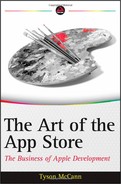9
Adopting Apple's Approach
- Learning what makes Apple's apps different
- Thinking about user experience as Apple does
- Discovering how Apple adapts its apps to the iPad
- Recognizing Apple's influence in top apps, and utilizing these techniques to improve your own
On May 9, 2011, according to Millward Brown, Apple passed Google to become the “world's most valuable brand,” increasing its brand value by 859 percent from 2006 to an estimated $153 billion. Google, according to the report, was a distant second at only $111 billion.
And, at the close of market trading on August 10, 2011, Apple passed Exxon Mobile as the world's most valuable company in terms of market capitalization, at roughly $337 billion. Later that month, Steve Jobs retired as CEO, with no business dragons left to slay.
To design something really well you have to get it. You have to really grok what it's all about. It takes a passionate commitment to thoroughly understand something — chew it up, not just quickly swallow it. Most people don't take the time to do that… The broader one's understanding of the human experience, the better designs we will have.
— STEVE JOBS
Apple's resurgence into the mainstream began in the late 1990s with the buzz-worthy iMac, available in several trendy colors as an all-in-one media system for the masses. Though it didn't catch on as much as Apple had hoped, it was profitable enough to keep it around in its many iterations. Even back then, Apple's approach to design (from hardware to software) was to retain simplicity, keep it ultra-user-friendly, and make it elegant. Apple's packaging was (and still is) second to none, and all this helped maintain an air of exclusivity when owning an Apple product. Apple's next device did catch on, and likely in a greater way than even it could imagine.
The first iPod music player was revealed in 2001, which started Apple's monopolization-by-great-design of the music market, a trend that continues to this day, and perhaps foreseeable into the future. It also helped to accelerate the already rapidly dwindling presence of retail music stores, and with iTunes, usher in a new age of digital downloading. What Apple did with the iPod was to fuse traditional button controls into a novel scroll wheel with a central input button and an approachable menu-driven interface. It was a lot like what Sony did with the Walkman back in the early 1980s, but also found a way to distribute all the music under one umbrella.
In 2007, Apple's portable domination branched and flourished with the release of the iPhone and iPod Touch, which revolutionized portable music players once again with natural multitouch gestures, a sleek icon-based interface, and the support of the market-leading App Store.
As of this writing, Apple is in iOS 5, and if tradition continues, the fifth generation of iPhones and iPod Touches, as well as the upcoming third generation of iPad, will no doubt push the iOS envelope further. While technology and software continue to change rapidly, one thing that doesn't is Apple's approach to design.
Sometimes it's enough to have a great business plan or idea, then capitalize on it in the most efficient manner, make your money, and move on. This chapter is for those who, for whatever reason, want to go the extra mile and infuse your app with the “secret sauce” that few apps attain — or at least look into what it takes to get there.
